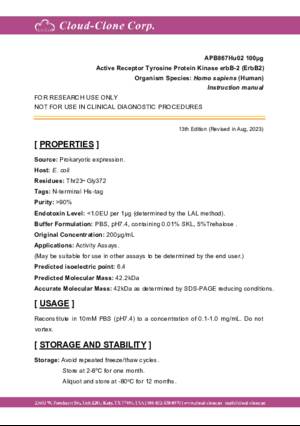Active Receptor Tyrosine Protein Kinase erbB-2 (ErbB2)
CD340; EGFR2; HER-2/neu; HER2; NEU; MLN 19; NGL; TKR1; p185; Epidermal Growth Factor Receptor 2; V-Erb-B2 Erythroblastic Leukemia Viral Oncogene Homolog 2; Neuro/Glioblastoma Derived Oncogene Homolog
- Product No.APB867Hu02
- Organism SpeciesHomo sapiens (Human) Same name, Different species.
- Buffer FormulationPBS, pH7.4, containing 0.01% SKL, 5% Trehalose.
- Traits Freeze-dried powder
- Purity> 90%
- Isoelectric Point6.4
- ApplicationsCell culture; Activity Assays.
- DownloadInstruction Manual
- UOM 10µg50µg 200µg 1mg 5mg
- FOB
US$ 290
US$ 725
US$ 1450
US$ 4350
US$ 10875
For more details, please contact local distributors!
ACTIVITY TEST

Receptor Tyrosine Protein Kinase erbB-2 (ErbB2) as known as HER2 (Human Epidermal Growth Factor Receptor 2), is a member of the EGFR family of receptor tyrosine kinases. It is a 185 kDa cell membrane receptor that plays a crucial role in cell signaling and proliferation.Besides,Plakophilin 2 (PKP2) has been identified as an interactor of ErbB2, thus a functional binding ELISA assay was conducted to detect the interaction of recombinant human ErbB2 and recombinant human PKP2. Briefly, ErbB2 was diluted serially in PBS with 0.01% BSA (pH 7.4). Duplicate samples of 100 μl were then transferred to PKP2-coated microtiter wells and incubated for 1h at 37℃. Wells were washed with PBST and incubated for 1h with anti-ErbB2 pAb, then aspirated and washed 3 times. After incubation with HRP labelled secondary antibody for 1h at 37℃, wells were aspirated and washed 5 times. With the addition of substrate solution, wells were incubated 15-25 minutes at 37℃. Finally, add 50 µL stop solution to the wells and read at 450/630nm immediately. The binding activity of recombinant human ErbB2 and recombinant human PKP2 was shown in Figure 1, and this effect was in a dose dependent manner.
USAGE
Reconstitute in 10mM PBS (pH7.4) to a concentration of 0.1-1.0 mg/mL. Do not vortex.
STORAGE
Avoid repeated freeze/thaw cycles. Store at 2-8°C for one month. Aliquot and store at -80°C for 12 months.
STABILITY
The thermal stability is described by the loss rate. The loss rate was determined by accelerated thermal degradation test, that is, incubate the protein at 37°C for 48h, and no obvious degradation and precipitation were observed. The loss rate is less than 5% within the expiration date under appropriate storage condition.
GIVEAWAYS
INCREMENT SERVICES
-
 BCA Protein Quantification Kit
BCA Protein Quantification Kit
-
 Molecular Mass Marker for Protein
Molecular Mass Marker for Protein
-
 Monoclonal Antibody Customized Service
Monoclonal Antibody Customized Service
-
 Polyclonal Antibody Customized Service
Polyclonal Antibody Customized Service
-
 Protein Activity Test Experiment Service
Protein Activity Test Experiment Service
-
 Electrophoretic Mobility Shift Assay (EMSA) Experiment Service
Electrophoretic Mobility Shift Assay (EMSA) Experiment Service
-
 Buffer
Buffer
-
 Lentivirus Packaging Experiment Service
Lentivirus Packaging Experiment Service
-
 Adenovirus Packaging Experiment Service
Adenovirus Packaging Experiment Service
-
 Real Time PCR Experimental Service
Real Time PCR Experimental Service
-
 Spike RBD Protein (S-RBD)
Spike RBD Protein (S-RBD)
-
 Protein G
Protein G
-
 Protein A
Protein A
| Magazine | Citations |
| Neuroscience Letter | Therapeutic effect of co-transplantation of neuregulin 1-transfected-Schwann cells and bone marrow stromal cells on spinal cord hemisection syndrom Cyagen: source |
| Journal of Electroanalytical Chemistry | A highly sensitive label-free electrochemical immunosensor based on AuNPs-PtNPs-MOFs for nuclear matrix protein 22 analysis in urine sample |







